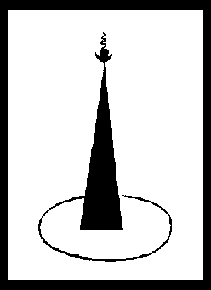It Is
William Stafford
(Graywolf)
-
"The bow bent remembers home long,
the years of its tree, the whine
of wind all night conditioning
it, and its answer --- Twang!
"To the people here who would fret me down
their way and make me bend:
By remembering hard I could startle for home
and be myself again."
 Here's what we think about American poetry --- old or new.
Here's what we think about American poetry --- old or new.For us to want to go to the trouble of reading it has to be new, passionate, rich, alive, funny (or sad), powerfully original.
When we glance through The Georgia Review, or The Virginia Quarterly Review, or The American Scholar, or The Southern Review, or Nimrod, The Nation, Poetry, Sequoia, The Michigan Quarterly Review --- we're pretty sure we'll be getting verse that fulfills none of these requirements.
God knows why people even bother to read, much less write, this rubbish. It's without love or life or --- how best to say it? --- nuts. It's not even as interesting as what the cat brings up in the morning, on the bathroom carpet, after being in the neighbor's garbage all night.
In William Safford's "Recoil" (reproduced at the top of this page) the message is one of those tedious Robert Bly homilies: "I'm a man. I may bend, but I have a long memory. I'm like a bow. If you try to fit me to your standards --- Twang!"
We have to ask ourselves three key questions:
- Does it work as a poem?
- If so, why?
- If not, is there any hope for the poet (or us)?
- Nope.
- Otiose message, otiose words: one doesn't "startle for home," unless one has problems with good English. Also, "Twang!" is clatter, a word that's inherently non-poetic.
- There is no hope for the poet, even if he were published, and published often (as he was) by the Brain-Dead Poets Society: The Georgia Review, The Virginia Quarterly Review, The Southern Review, and all the others mentioned above.
Stafford died in 1993. Ostensibly, The Way It Is is a memento mori. For his publishers, it must be requiescat in pace.
For us, it is more rigor mortis.
Most Dangerous
Places
Robert Young Pelton
(Fielding)
Remember that old wheeze, "First Prize, a week in Philadelphia. Second Prize, a month in Philadelphia."
Well, now you can say "First Prize, a trip to Afghanistan, Chechnya, and Pakistan. Second Prize, all of the above, with Albania, Burundi, Liberia, Iran, and North Korea thrown in."
This Robert Young Pelton, not to be confused with the late actor Robert Young, has been to them all, and wants you to know how awful they are, even though there is a wryness in his often harsh words: under Iran, we get "Ayatollah Not to Come;" Pakistan is "Dodge City with Skiing;" India: "Kashmir Sweat."
It's big (almost a thousand pages) and comprehensive and absolutely stuffed, a full baked potato with bacon, sour cream, chives --- as well as a few bombs. On the Congo (Zaire):
- Joseph Conrad based his famous tale of depravity and corruption on this dying, diseased land when it was called the Belgian Congo. It is hot, violent, and dark. Whether it's the bloodshot eyes of your first customs inspector or the apocalyptic way the earth reclaims the symbols of civilization, you will always remember your first trip to the dark heart of Africa...
And this on the police in Zaire:
- Cops make a maximum of about US$50 a month, if and when they get paid. There's no back pay if the accountants miss a pay day. That's where you come in. If you are stopped by the police for whatever reason, you will be considered a necessary part of the foreign economic investment in their country...If you are waylaid by a real criminal don't bother reporting it.
And this on diseases:
- It is almost pointless listing the various health problems in Central Afrisa since most of them originate here. Getting sick in Congo is as inevitable as it is debilitating. This is the home of Ebola and a future incubator of some of the world's nastiest diseases.
Get the picture? This is your anti-travel guide --- a purge for all the Fodors and all those giddy travel sections in your home-town newspaper. There are thirty-four dangerous countries listed, with are another twenty-four "Coming Attractions" --- including The Basque Country, Northern Ireland, and Panama. The descriptions are cynical, and scary, but the real prizes in The World's Most Dangerous Places are the charts and lists.
What are the most dangerous places in the world for European travelers? In reverse order: Kenya, California, Turkey, North Africa, with the worst being (get this!) Florida. Want to know about wars --- certainly dangerous for those seeking fun in the sun: almost sixty wars or "police actions" during the last fifty years are listed. Those with the most killed?
- Cambodia --- 2,000,000
- Tibet --- 1,200,000
- Rwanda --- 500,000
- Somalia --- 500,000
- Iraq --- 430,000
- Angola --- 400,000+
- Indonesia --- 362,500
Land mines? Under the subchapter called "Stumps 'R Us," we find that they are produced in and exported from not only the United States, but from Canada, Italy, Chile, and Brazil, too. The United States leads the pack in "Numbers of Model Sold" (37), but Italy is close behind with 36, Russia with 31, and peace-loving Sweden, 21.
The World's Most Dangerous Places is written in a style that's a cross between what you would find in books by Hunter Thompson, and in magazines like "Soldier-of-Fortune," but, despite the occasional overstatements (because of traffic fatalities in Rome, Madrid or Cairo, you're much safer on the streets of Belfast; the dangers in Mexico are somewhat exaggerated) there is a directness and an honesty that should make this required reading by not only would-be tourists, but by those who govern our country as well.
For example, in a section devoted to why you and I might well be considered Ugly Americans to citizens in other countries, the author reports:
- Do Russia and the United states have the right to military interference in foreign countries? Do aid programs actually create starvation and suffering by artificially shifting populations to refugee camps, and thereby increasing the birth rate and then creating total disaster when the supplies stop? America's biggest fault is that we instinctively rush in to save the world when the starving children and shattered bodies hit the headlines, but when we actually learn the real complexities and cost we recoil in horror and disappear.
Much of the anger toward Americans is a direct result of others' perception of our need to control foreign governments. If the government feels it lacks sufficient political clout in certain regions of the world, it brings out the checkbook. The U. S. bought peace in the Middle East by writing checks to both sides, thereby aggravating fanatics on both sides. We also support a wide variety of dictators, despots, and other nondemocratically elected rulers because they are less antagonistic toward the U. S.
The U. S. also wages financial, moral, covert (and not so covert) operations against enemies of the state, such as the Islamic fundamentalists, drug dealers, unfriendly dictators, and gangsters. We do this by supporting (or sometimes creating) opposition forces with money, weapons, and military training. This creates a lot of ill will towards "Americans" regardless of their beliefs or background....You may find it surprising to see how obvious the U. S. "covert" presence is in Third World countries. Terrorist groups keep very good tabs on CIA and other government agents in their countries. And hey guess what? Spies look just like you.
Inner Fire
Heart Practice of the
Six Yogas of Naropa
Lama Thubten Yeshe
(Wisdom)
When they send you out to meet your master, pray that it is Lama Yeshe. After spending a few hours with him, you will know that you have found the Sancho Panza of Tibetan Buddhism.
His shtick is something called "Inner Fire," and he loves it (he says that it's the "real chocolate.")
- Whereas you may find it difficult to get results with other meditations, inner fire is a sensitive, quick way to convince yourself that you are progressing. It will surprise you. When you practice it you will think, "What else do I need? This is the only way." Other practices will seem second-rate.
Lama Yeshe's message is one of vibrant enthusiasm, but also of caution:
- During periods of intensive inner fire meditation, you should not sit too close to fires or get sunburned, as this may stimulate the wrong energies. It doesn't matter when you are not meditating intensively: at those times you can go to the beach as usual and burn yourself to a brown color.
 The key, the focus of your meditation, is something called the short a. It is located just below the navel, running in front of and on both sides of the spine. It looks like this:
The key, the focus of your meditation, is something called the short a. It is located just below the navel, running in front of and on both sides of the spine. It looks like this:
Lama Yeshe's master was Lama Tsongkhapa who, he says, was a master of "perfect renunciation." The Emperor of China had come to visit with him, to invite him to his palace. Yeshe says,
- He vomited at the thought of worldly pleasure. Can you imagine us in that situation? We would definitely accept the invitation. I can't even resist an invitation to visit a rich benefactor, let alone an emperor.
Wisdom Publications has put out a wonderful series on Tibetan Buddhism. The Bliss of Inner Fire is one of their best.